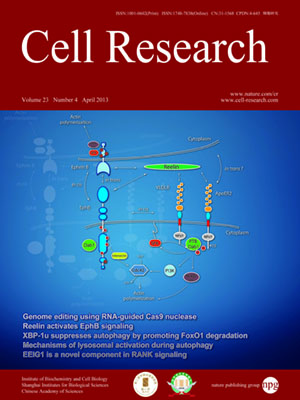
Volume 23, No 4, Apr 2013
ISSN: 1001-0602
EISSN: 1748-7838 2018
impact factor 17.848*
(Clarivate Analytics, 2019)
Volume 23 Issue 4, April 2013: 565-572
ORIGINAL ARTICLES
Trinucleotide repeat expansions catalyzed by human cell-free extracts
Jennifer R Stevens1, Elaine E Lahue1, Guo-Min Li2 and Robert S Lahue1
1Centre for Chromosome Biology, School of Natural Sciences, National University of Ireland Galway, Distillery Road, Galway, Ireland
2Graduate Center for Toxicology and Markey Cancer Center, University of Kentucky College of Medicine, Lexington, KY 40536, USA
Correspondence: Robert S Lahue,(bob.lahue@nuigalway.ie)
Trinucleotide repeat expansions cause 17 heritable human neurological disorders. In some diseases, somatic expansions occur in non-proliferating tissues such as brain where DNA replication is limited. This finding stimulated significant interest in replication-independent expansion mechanisms. Aberrant DNA repair is a likely source, based in part on mouse studies showing that somatic expansions are provoked by the DNA repair protein MutSβ (Msh2-Msh3 complex). Biochemical studies to date used cell-free extracts or purified DNA repair proteins to yield partial reactions at triplet repeats. The findings included expansions on one strand but not the other, or processing of DNA hairpin structures thought to be important intermediates in the expansion process. However, it has been difficult to recapitulate complete expansions in vitro, and the biochemical role of MutSβ remains controversial. Here, we use a novel in vitro assay to show that human cell-free extracts catalyze expansions and contractions of trinucleotide repeats without the requirement for DNA replication. The extract promotes a size range of expansions that is similar to certain diseases, and triplet repeat length and sequence govern expansions in vitro as in vivo. MutSβ stimulates expansions in the extract, consistent with aberrant repair of endogenous DNA damage as a source of expansions. Overall, this biochemical system retains the key characteristics of somatic expansions in humans and mice, suggesting that this important mutagenic process can be restored in the test tube.
Cell Research (2013) 23:565–572. doi:10.1038/cr.2013.12; published online 22 January 2013
FULL TEXT | PDF
Browse 2152


